By Sandrine Soubeyran and Robin Marshall, Global Investment Research, FTSE Russell
- BoC Tightening and Inflation Risks: The blog raises the question of whether the recent rate hike by the BoC may have been excessive, given the decline underway in Canadian inflation and signs the labour market is cooling
- It explores the possibility the June and July tightening measures are designed as pre-emptive inflation insurance by the BoC…
- …. aimed at defusing risks of inflation expectations destabilising, given the lagged effects of monetary policy and extreme monetary stimulus in 2020-21.
The Bank of Canada has been fully transparent with its monetary policy since the Covid recovery, having promptly responded to inflation accelerating by raising rates, and switching from quantitative easing to quantitative tightening starting in Q2 2022 (Chart 1). But after two months of policy pauses and apparent success in cooling the economy, the BoC shocked markets by raising rates 25bp in June and a further 25bp in July, despite signs of economic softening. Why did the BoC feel the need to implement two small rate increases of 25bp in the last two months? Were these increases too far?

The BoC justified its first move, in June, on the basis the economy “was stronger than expected in the first quarter of 2023, with GDP growth of 3.1% and consumption growth was surprisingly strong and broad-based… [while] housing market activity has picked up. Overall, excess demand in the economy looks to be more persistent than anticipated”. The second move focused more on “[slower] downward momentum in inflation” due to strong demand, household spending, population growth and accumulated household savings.
But by most measures and, also acknowledged by the BoC, the Canadian economy has since been slowing. This justified the BoC’s decision to pause policy in March and April after the interest rate increase in January this year, unlike other central banks, which continued to tighten policy. Rate hikes in the UK, Eurozone and US were deemed necessary, and well flagged (i.e., Eurozone), as inflation levels stayed stubbornly high, despite recent easing, though the UK was an exception, as inflation remained unchanged at 8.7% y/y since May, and core inflation accelerated.
But in Canada, CPI May inflation fell close to its 2% target, at 3.4% y/y, from 4.4% in April, and the BoC had indeed forecast the inflation rate to drop to “3% in the summer, as lower energy prices feed through and last year’s large price gains fall out of the yearly data”. Core inflation (ex-food & energy) also fell to 3.7% y/y (Chart 2). The recent sharp fall in US CPI inflation in June was also very encouraging.
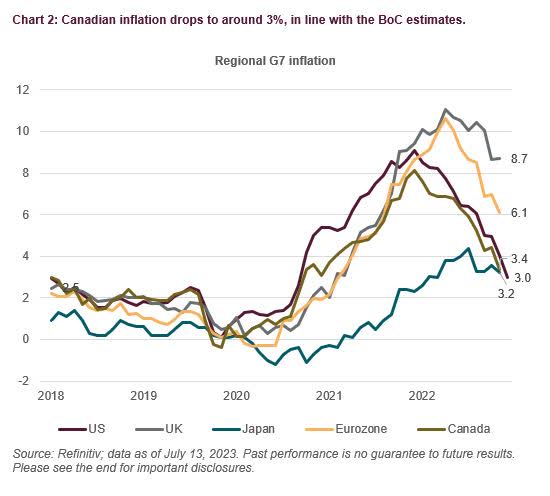
Moreover, the Canadian bond market has been signaling recessionary risks since last June, as can be observed by the deeply negative spreads and deep yield curve inversions over the last twelve months in Chart 3. Both 10/2 and 20/2 yield curves have fallen well through -100bp, with 20/2s currently close to -150bp at the time of writing.
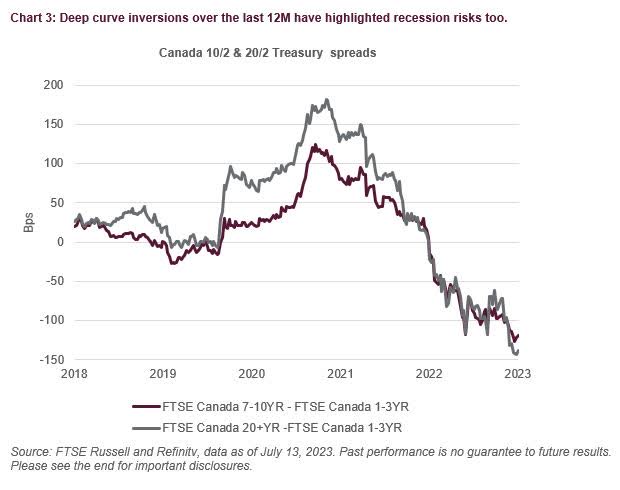
Other macroeconomic measures have also confirmed Canada’s economic slowdown. Canadian wage inflation, while still robust, has eased (Chart 4), and although unemployment remains close to historical lows, the latest figure has also ticked up modestly, moving away from its lows.
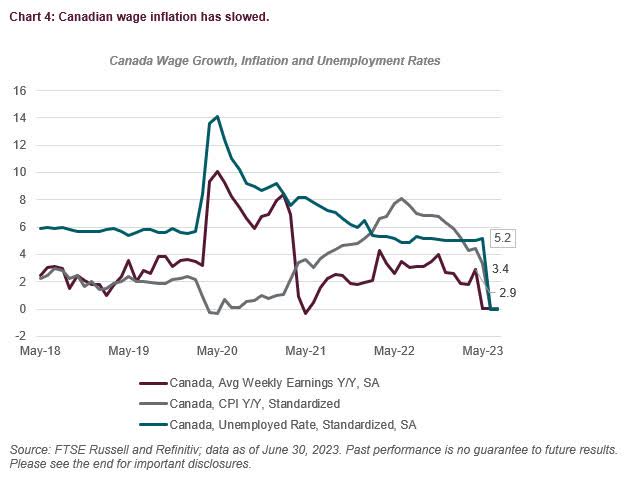
Even so, the strength of domestic demand and consumption has remained a worry. As Chart 5 shows, retail sales, in value terms, bounced back strongly in May in absolute terms, though the broader trend appears to be stabilising. However, from a year-on-year perspective, the percentage change highlights a clear cooling as seen in Chart 6. Much of this appears to have been funded from the Covid windfall in savings, accumulated during the Covid lockdown (Chart 7). Other measures such as Canadian housing starts have also weakened.
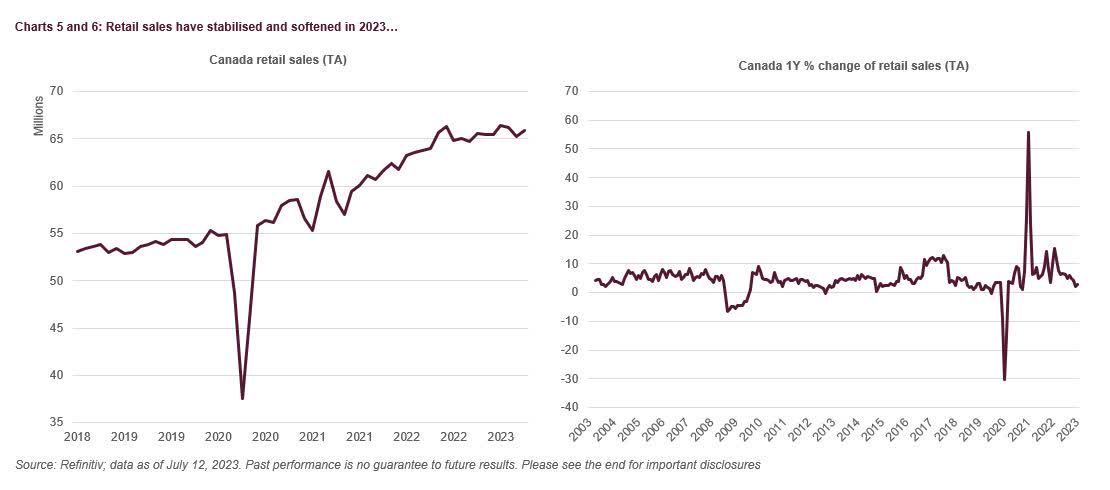
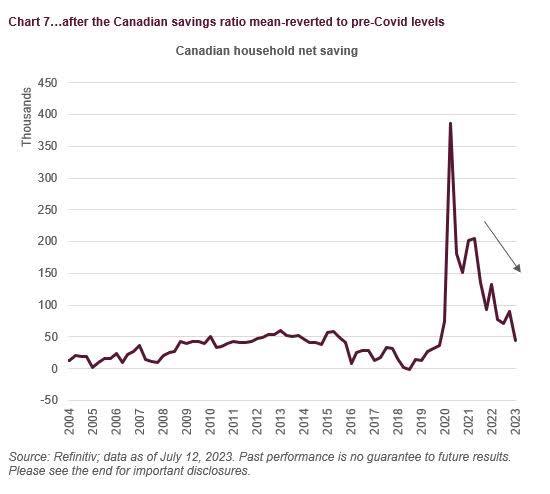
A BoC tightening too far?…
The weakening Canadian economy raises the question as to whether the latest 0.25% BoC rate rise this month may have been an increase too far and could send the economy into a deeper slowdown than necessary. After all, the Canadian economy does not have the same degree of labour market tightness, wage and price inflation as some G7 members, notably the UK. In addition, the BoC’s flexible inflation targeting regime allows the BoC flexibility in bringing inflation back to the 2% target over time [1]and includes an objective to maximise employment and preserve financial stability.
…or insuring against an inflation regime change
An alternative explanation is recent moves may represent an attempt to claw back some of the extreme monetary stimulus applied in 2020-21 and to defuse risks of inflation expectations de-stabilising. If monetary policy worked with no lag to affect inflation and output growth, this task would be more straightforward, and the BoC would have more room to wait and react if inflation expectations destabilised.[2]But estimates of the policy lag suggest this may be as long as one or two years, so a pre-emptive tightening becomes more necessary, if policy works with a lag, and there is a risk of inflation regime change.
[1] BoC inflation targeting regime.
[2] See “Monetary Policy Lag, Zero Lower Bound, and Inflation Targeting”, Shin-Ichi Nishiyama, BoC Working Paper, January 2009.
© 2023 London Stock Exchange Group plc and its applicable group undertakings (the “LSE Group”). The LSE Group includes (1) FTSE International Limited (“FTSE”), (2) Frank Russell Company (“Russell”), (3) FTSE Global Debt Capital Markets Inc. and FTSE Global Debt Capital Markets Limited (together, “FTSE Canada”), (4) FTSE Fixed Income Europe Limited (“FTSE FI Europe”), (5) FTSE Fixed Income LLC (“FTSE FI”), (6) The Yield Book Inc (“YB”) and (7) Beyond Ratings S.A.S. (“BR”). All rights reserved.
FTSE Russell® is a trading name of FTSE, Russell, FTSE Canada, FTSE FI, FTSE FI Europe, YB and BR. “FTSE®”, “Russell®”, “FTSE Russell®”, “FTSE4Good®”, “ICB®”, “The Yield Book®”, “Beyond Ratings®” and all other trademarks and service marks used herein (whether registered or unregistered) are trademarks and/or service marks owned or licensed by the applicable member of the LSE Group or their respective licensors and are owned, or used under licence, by FTSE, Russell, FTSE Canada, FTSE FI, FTSE FI Europe, YB or BR. FTSE International Limited is authorised and regulated by the Financial Conduct Authority as a benchmark administrator.
All information is provided for information purposes only. All information and data contained in this publication is obtained by the LSE Group, from sources believed by it to be accurate and reliable. Because of the possibility of human and mechanical error as well as other factors, however, such information and data is provided “as is” without warranty of any kind. No member of the LSE Group nor their respective directors, officers, employees, partners or licensors make any claim, prediction, warranty or representation whatsoever, expressly or impliedly, either as to the accuracy, timeliness, completeness, merchantability of any information or of results to be obtained from the use of FTSE Russell products, including but not limited to indexes, data and analytics, or the fitness or suitability of the FTSE Russell products for any particular purpose to which they might be put. Any representation of historical data accessible through FTSE Russell products is provided for information purposes only and is not a reliable indicator of future performance.
No responsibility or liability can be accepted by any member of the LSE Group nor their respective directors, officers, employees, partners or licensors for (A) any loss or damage in whole or in part caused by, resulting from, or relating to any error (negligent or otherwise) or other circumstance involved in procuring, collecting, compiling, interpreting, analysing, editing, transcribing, transmitting, communicating or delivering any such information or data or from use of this document or links to this document or (B) any direct, indirect, special, consequential or incidental damages whatsoever, even if any member of the LSE Group is advised in advance of the possibility of such damages, resulting from the use of, or inability to use, such information.
No member of the LSE Group nor their respective directors, officers, employees, partners or licensors provide investment advice and nothing in this document should be taken as constituting financial or investment advice. No member of the LSE Group nor their respective directors, officers, employees, partners or licensors make any representation regarding the advisability of investing in any asset or whether such investment creates any legal or compliance risks for the investor. A decision to invest in any such asset should not be made in reliance on any information herein. Indexes cannot be invested in directly. Inclusion of an asset in an index is not a recommendation to buy, sell or hold that asset nor confirmation that any particular investor may lawfully buy, sell or hold the asset or an index containing the asset. The general information contained in this publication should not be acted upon without obtaining specific legal, tax, and investment advice from a licensed professional.
Past performance is no guarantee of future results. Charts and graphs are provided for illustrative purposes only. Index returns shown may not represent the results of the actual trading of investable assets. Certain returns shown may reflect back-tested performance. All performance presented prior to the index inception date is back-tested performance. Back-tested performance is not actual performance, but is hypothetical. The back-test calculations are based on the same methodology that was in effect when the index was officially launched. However, back-tested data may reflect the application of the index methodology with the benefit of hindsight, and the historic calculations of an index may change from month to month based on revisions to the underlying economic data used in the calculation of the index.
This document may contain forward-looking assessments. These are based upon a number of assumptions concerning future conditions that ultimately may prove to be inaccurate. Such forward-looking assessments are subject to risks and uncertainties and may be affected by various factors that may cause actual results to differ materially. No member of the LSE Group nor their licensors assume any duty to and do not undertake to update forward-looking assessments.
No part of this information may be reproduced, stored in a retrieval system or transmitted in any form or by any means, electronic, mechanical, photocopying, recording or otherwise, without prior written permission of the applicable member of the LSE Group. Use and distribution of the LSE Group data requires a licence from FTSE, Russell, FTSE Canada, FTSE FI, FTSE FI Europe, YB, BR and/or their respective licensors.
Original Post
Editor’s Note: The summary bullets for this article were chosen by Seeking Alpha editors.
Read the full article here












